Steve Collins
Reviews By Author
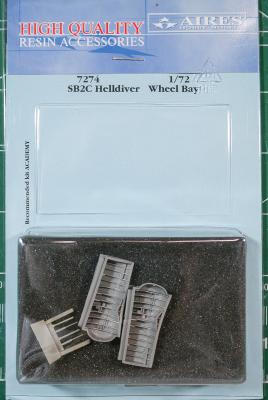
|
SB2C Helldiver Wheel BayPublished:
This Aires accessory wheel bay set is made for the Academy SB2C-4 kit. As you can see from the photos, the kit’s molded-in wheel bay details are found on both the top and bottom halves of the wing. The resin replacement bays are single pieces with additional detail inside each bay. The instructions will have you remove the molded-in details on each upper and lower wing and replace them with a one-piece resin bay. This will prevent any seams from showing inside the wheel well. You also get replacement pieces for the gun tubes that go through the outboard end of the wheel wells as well as a retraction rod for the landing gear. All of the parts are nicely cast in Aires’ customary medium grey resin; they are well molded and bubble free. This set is certainly recommended. … more |
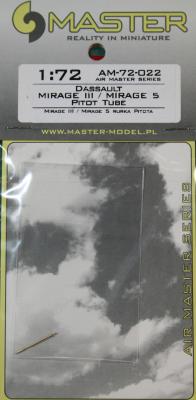
|
Dassault Mirage III/5 Pitot TubePublished:
This is one of a prolific series of very fine brass replacements for pitot tubes and gun barrels from Master Model Poland. They do ranges in 1/24, 1/32, 1/35, 1/48 and 1/72 for aircraft as well as guns in all the major scales for ships and a few guns in 1/35 for our armor-building friends. They are all very well made, being very petite and usually more in scale than their plastic counterparts. And, once installed, they’re much harder to accidentally break off than plastic. Yes, some of them are sharp enough puncture the less than vigilant. Ask me how I know. This pitot was made to replace the pitot in any Mirage III or Mirage 5 kit. In the included pictures, I compare the brass pitot to the plastic one from the Heller Mirage IIIE/R/5BA kit as well as the Mirage IIICJ from AML.… more |
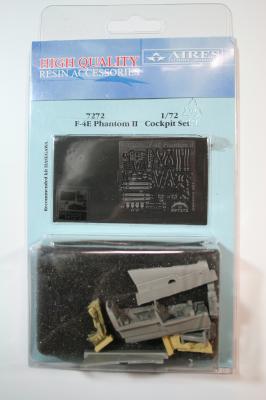
|
F-4E Phantom II Cockpit SetPublished:
The Aires F-4E cockpit set is typical of most of their cockpits. The set is made up of resin, photoetch, and an acetate sheet. Cast in a medium grey resin, the detail is very sharp and very complete. Included in resin in the set are the cockpit tub with both side consoles and the rear bulkhead of each pit molded in, side panels for each side that have detail for both pits, the rear instrument panel with detail of the back side of the instruments on the upper half of the panel, the front instrument panel cast in place with the glare shield and radar reflector glass, two seats without belts, and a sprue with both control sticks, a control grip for the radar, the radar display unit for the back pit, the scope hood for the radar, throttles for both pits, and an insert for the canopy bow… more |
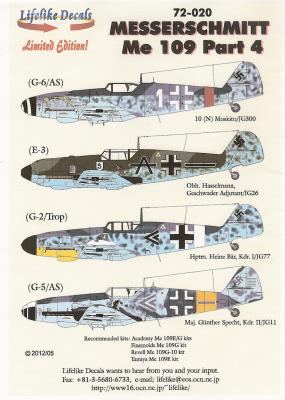
|
Messerschmitt Me109 Part 4Published:
I like the way Lifelike does their decals. They pick a type of aircraft and give you markings for several variants of that aircraft, rather than four or six of one type. This sheet contains markings for four Me109s. They are an Me109G-6/AS from 10 (N) Moskito/JG300, a high-altitude version with a yellow comet on the nose, a Bf109E-3 flown by Oblt. Hasselmann, the Geschwader Adjutant of JG26, an Me109G-2/Trop belonging to Heinz Bär when he was Kommodor of I/JG77, and an Me109G-5/AS of Maj. Günther Specht, Kommodor of II/JG11. The instruction sheet is in full color, with side views of the aircraft showing the camouflage and decal placement. The decals are thin, in register, with what seems to be accurate colors. So, as you can see, one sheet gives four fairly widely… more |
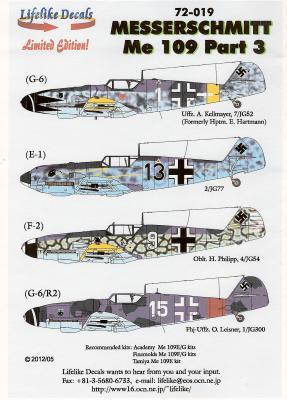
|
Messerschmitt Me109 Part 3Published:
I like the way Lifelike does their decals. They pick a type of aircraft and give you markings for several variants of that aircraft, rather than four or six of one type. Personally, I don’t think I’ll be doing four Bf109E-1s, but I might do an E-1, an F-2, a G-6, and a G-6/R2. That’s what’s on this sheet. You get markings for four different variants of the Bf109 (or Me109, depending on when). The Bf109E-1 is from 2/JG77 with a yellow lightning bolt on the side of the fuselage. The Me109F-2 is Oblt. Hans Philipp from 4/JG54 with a prominent green and grey camo sprayed on the fuselage sides. The Me109G6 is flown by Uffz. A. Kellmayer of 7/JG52, an aircraft that previously belonged to Eric Hartmann. The last aircraft is an Me109G-6/R2 with an oversprayed grey and dark green camouflage… more |

|
Micro Mitre BoxPublished:
The UMM Micro Mitre Box is a useful little tool if you’re scratchbuilding or adding detail to a model. Made of aluminum, it’s designed for cutting wood, metal, or plastic using their JLC razor saw. As an aside, it also works with other brands of razor saw, so long as they’re not over .12” thickness. This version of their box allows cuts at 45°, 60°, and 90°. They have recently released an updated version of the box (Micro Mitre Box II) which has a brass rule imbedded in the box that is marked in 1mm increments. There is an adjustable stop device that is screw-mounted in the bottom of the box. It has a flat end and a slanted end to be used to hold the material in place. There are several screw holes to allow the stop to be almost infinitely adjusted for length. I have used the… more |
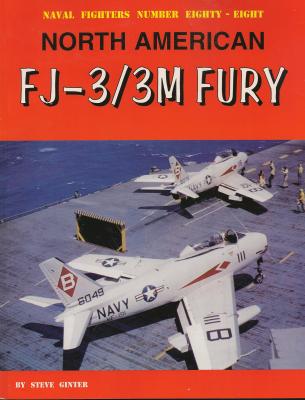
|
Naval Fighters 88 – FJ-3/3M FuryPublished:
The FJ Fury series of aircraft has always interested me. I think mostly that’s because they were initially developed along with the F-86. Early decisions by the Navy resulted in their first version having straight wings, but they got their jet first. Of course, research into the information gathered from the Germans at the end of World War II showed that the swept wing was the way to go and the Navy eventually came around to the Army’s (later Air Force’s) way of thinking, resulting in the FJ-2. This aircraft was very similar to the Air Force’s F-86A. Improvements and more powerful engines for the FJ-2 led to the FJ-3, wherein the development started to diverge more and more from the F-86. Yet further developments let to the FJ-4 and FJ-4B Fury. This book is typical of Steve… more |
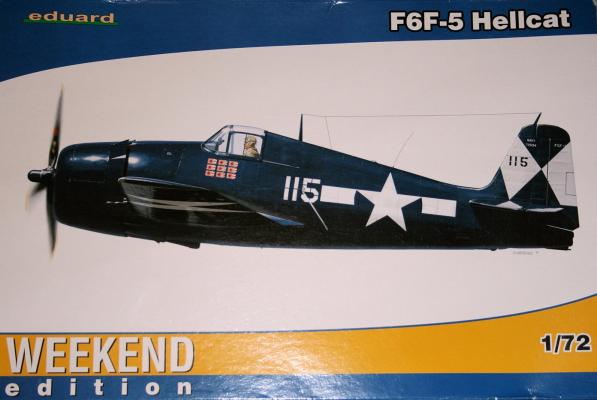
|
F6F-5 Hellcat Weekend EditionPublished:
Everybody probably knows that Eduard has a series of Hellcats available in 1/72. Everyone probably also knows that one of their competitors has released a similar series. The question arises as to which kit is better. In my opinion, the answer is a qualified neither. Both kits have strengths and weaknesses. I’ll be discussing those of the Eduard kit. Please note first that this build incldues the following aftermarket: |
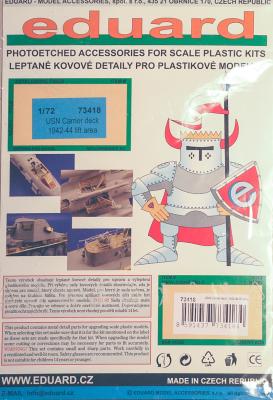
|
USN Carrier Deck 1942-44 Lift AreaPublished:
This product is a prepainted photoetched flight deck section from a US carrier between 1942 and 1944. It is made of a fairly heavy gauge brass. It partly includes one of the hangar deck lifts in the full up position. It has good texture showing the planking on the deck, the tiedown strips and the metal areas surrounding the lift, as well as some of the deck markings for the carrier. The painting gives a realistic replication of the wood grain on the deck planks and is of the early war natural wood coloring. The surface has a slight sheen, and to be more realistic, it should have a light coat of flat clear sprayed on. The deck section is big enough for a small naval aircraft, and would probably be okay with a Hellcat or a Corsair. It measures 4 3/8 x 5 1/4 inches or… more |
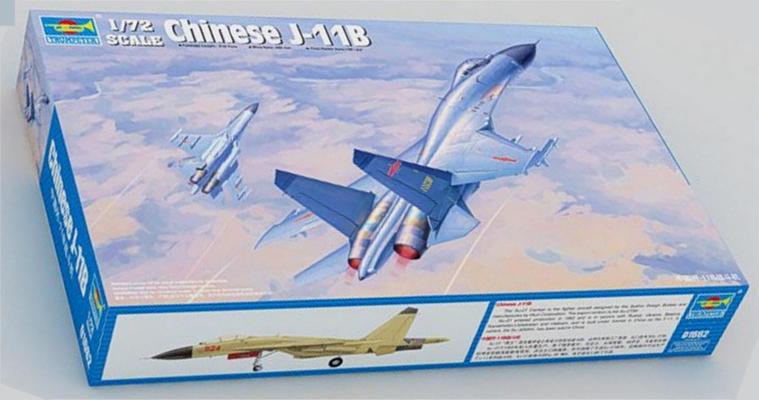
|
Chinese J-11BPublished:
The J-11B (NATO code name Flanker B+) is a Chinese version of the Sukhoi Su-27SK. The first 100 J-11A aircraft were built under license from Sukhoi. After those were completed, the license was suspended. Soon thereafter, the Chinese announced they had developed a multi-role version known as the J-11B. The Trumpeter kit seems to be a scale-down version of their larger kit. It covers the aircraft configured for air-to-air combat, capable of carrying no fewer than 12 missiles. Yep, 12. The kit is 10 trees plus the fuselage top and bottom molded in Trumpeter’s standard medium hard grey plastic with engraved panel lines. The fuselage is molded in top and bottom halves including the wings. Optional parts are included, such as vertical stabilizers, wingtip rails, and exhausts,… more |
